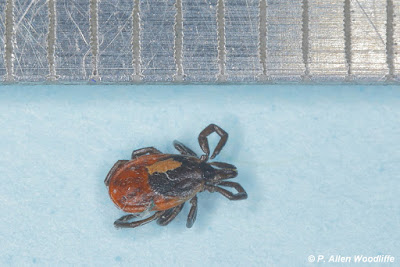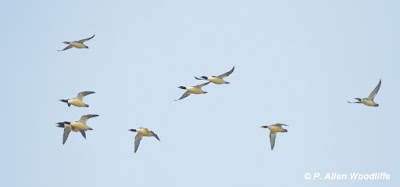In one of the recent warmer periods, Marie noticed our first Dandelion in bloom in the yard.
On another occasion, a day when the temperatures approached 10C and we were hiking at Rondeau, she discovered a Black-legged Tick on her person after we got home. Fortunately she found it before it got too attached to her. It was definitely a reminder that especially when the temperatures are above freezing, ticks may emerge from their underground cold weather hangouts and be prowling about looking for a blood meal! Therefore even at this time of year under those conditions there is a risk of contracting Lyme Disease.
I was out doing a waterfowl survey along the southern limits of Lake St. Clair. On my way I noted an American Kestrel on a wire.
Not being satisfied with this distant photo, I attempted to drive a bit closer, but as many raptors distrust humans when being approached, this one left the wire and landed on a corn stalk out in a field. Even knowing where it landed, it was not easy picking it out and one could easily miss it. This next photo is taken at an equivalent of about 16X. The camouflage in this kind of light and setting is quite effective.
Cropping it to the equivalent of at least 35X and it stands out a bit better.
At the Jeannette's Creek boat launch, I stopped to see what waterfowl was around. While scanning for them, I was amazed at the number of Bald Eagles there were....42 at the minimum were visible from this location, and another 3 at the mouth of the river. This next image, complements of Google shows the river just as it enters Lake St. Clair. The X is the boat launch area, and the BE indicates where the bulk of the eagles were, at least what I could see. Who knows how many were just around the bend? On the recently held St. Clair NWA Christmas Bird Count, we officially tallied 50 Bald Eagles for the count circle, although unofficially we tallied 60. But since some may have been double counted due to their movements, we reduced the total to 50. Now with seeing a minimum of 45 of them from one general vantage point and only a small part of the count circle, maybe even 60 for the bird count was low.
I took a few shots, but the distance was pretty far. In this first photo one can see 14 eagles either in the trees or in the air. There are a couple of Herring Gulls flying as well.
At the mouth of the river, one of the three eagles there at least was close enough and in pretty good light to provide a better photo op.
With the river being totally open, there were various waterbirds to be seen, including about 15 Great Blue Herons along the far shoreline. At least they were in good light, enjoying the bright sunshine.
The next photo shows two herons, one at either side, as well as a couple of Double-crested Cormorants on the log. Not the closest, but that was as close as I could get.
There was an impressive number of ducks on the river, mostly Mallards but also Common Mergansers. The mergansers were actually not too far from where many of the eagles had gathered. Shortly after I checked over the eagles, the mergansers headed downstream flying right by me in various sized groups.
I had also been to Rondeau on a couple of occasions, in part to see if the Barred Owl was still around in the campground area. Unfortunately no one has seen the owl since Jan 6. But there were other species to find, such as the ongoing Baltimore Oriole in the campground which I came across a couple of times....
....as well as scattered groups of White-throated Sparrows, Northern Cardinals and Dark-eyed Juncos. One or more Yellow-bellied Sapsuckers have continued in the campground as well.
The lake has fewer and fewer birds on it.....I haven't seen any Red-throated Loons for a few days now. A small group of Ruddy Ducks had been hanging out off the northeast part of the park for a week or two. Here there are about 27 of them. Other single ducks join them from time to time, including scaup and scoters, but this image is all Ruddies.
Now that the bay is freezing over, there are thousands of Tundra Swans (4000+) and Canada Geese (3000+) scattered across it, as well as a much smaller number of ducks. However they are well out in the middle and difficult to photograph on a sunny day with all of the sunlight interference. Not as much of a problem when they are flying, fortunately.
Feeders haven't been terribly active since it has been relatively mild with absolutely no snow cover. But some of the regulars are there when there is food for them.
With the onset of colder weather along with snow that stays, it is imperative for feeders to be well-stocked with food.

























I knew there were bald eagles "down south" but had no idea they were in such numbers. I'd assume there is food for them there, to cause the congregation like that? Gord.
ReplyDeleteCertainly the number of Bald Eagles has increased in Ontario and elsewhere dramatically since the late 1900s. With lots of open water, they feel less inclined to move farther south than they need to. I expect there are enough crippled ducks and dead fish in the extensive marshes and adjacent lake to satisfy their needs for now. They will go after muskrats as well, and again with the marshes not being frozen up until now, the local muskrat population would add to the potential food supply for the eagles. It will be interesting to see if the numbers remain the same as things freeze up making their food source less available.
Delete